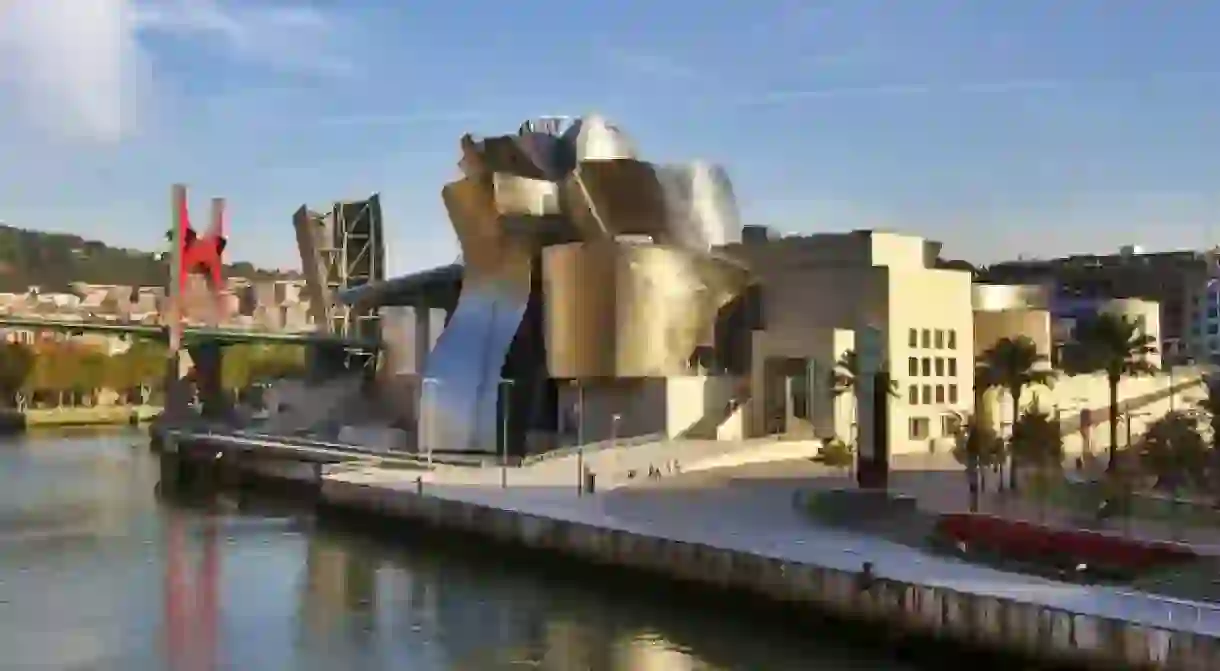The Guggenheim Bilbao: Making Art History

Frank Gehry’s Guggenheim Museum Bilbao is a striking masterpiece of contemporary architecture, serving as a leading destination for modern and contemporary art and design. From the building’s lustrous outer layer of titanium tiles to the plethora of world-class displays housed in its cavernous interior, it is no surprise that the museum has drawn over ten million visitors since its opening.

Inaugurated by former King Juan Carlos I in 1997, this radical museum brought modern architecture soaring into the third millennium in style – with the city of Bilbao in tow. Almost overnight, the landmark transformed this northern Spanish city from a declining post-industrial center, once famed for its shipbuilding, into a cultural and architectural hub. The museum, set in the city’s former industrial district, spearheaded Bilbao’s urban regeneration project and turned the city into a tourist hotspot, with the resulting influx of visitors meaning that the building — which cost $100 million to build — has more than paid for itself. The museum’s miraculous transformation of the city resulted in the coining of the term the “Guggenheim effect.”
So what is the story behind this monumental masterpiece? As part of the regeneration plan for the region, the Basque authorities collaborated with the Solomon R. Guggenheim Foundation, and put forward the idea of constructing a Guggenheim museum in Bilbao’s declining port area. Three renowned architects were invited to participate in an international competition to develop a visionary design for the museum: Arata Isozaki from Japan, Austrian Coop Himmelb(l)au, and Frank Gehry, hailing from Canada and the US. The winner was, of course, Frank Gehry, whose use of computer-assisted design technology helped him transform his poetic visions into the impressive structure we see today.

Located on a 32,500-square-meter site beside the Nervión river, Gehry’s nautically themed design merges seamlessly into the urban landscape, with its ship-like shape and titanium fish tails evoking the city’s nautical and industrial heyday, while its glass panels invite visitors inside the museum to embrace the city’s modern-day landmarks.
The museum provides visitors with a range of permanent and temporary exhibits from artists all across the globe. In 1997, the museum opened its doors with The Guggenheim Museums and the Art of this Century, a selection of 300 pieces spanning 20th century art, beginning with European masterpieces by the likes of Picasso, Miró, Matisse and Chagall, moving onto American Pop Art with works by Claes Oldenburg and Andy Warhol, and finishing with examples of Arte Povera and modern, video-based work.
With a huge 11,000 square meters of exhibition space, the museum is divided into 19 galleries, the largest of which is the Arcelor Gallery measuring 130 metres in length. This gallery houses the permanent exhibit The Matter of Time, a collection of seven undulating weathering steel sculptures by Richard Serra, created with this specific gallery in mind. Additional site-specific works include Jenny Holzer’s Installation for Bilbao, featuring nine columns of electronic LED signs displaying unsettling phrases in English, Spanish and Basque (based around the themes of death and intimacy) that race upwards onto the reflective ceiling.
But the museum’s site-specific works are not limited to the interior; Jeff Koons’ Puppy, a 13-meter tall steel structure of a West Highland terrier puppy decked out in thousands of flowers guards the museum entrance, while Tulips, a huge bouquet of multicoloured stainless steel balloon flowers by the same artist adds a splash of color to the riverbank, just a scuttle away from Louise Bourgeois’ giant spider sculpture, Maman. Standing between the museum and the river is Fujiko Nakaya’s Fog Sculpture #08025 (F.O.G.) (“F.O.G.” is said to stand for “Frank O. Gehry” but the sculpture does indeed consist of fog rebounding off the reflective ripples of both the water and the building), while in the same vicinity, Yves Klein’s Fire Fountain treats visitors to a display of dancing flames at dusk.

Considered by many critics as one of the best contemporary art museums in Europe, the future of this gleaming museum certainly looks bright. While its permanent collection is gradually maturing, its connections with other major Guggenheim museums in New York, Venice and Berlin grant it continual access to some of the 20th century’s greatest masterpieces.














